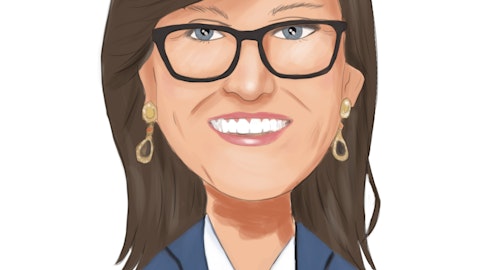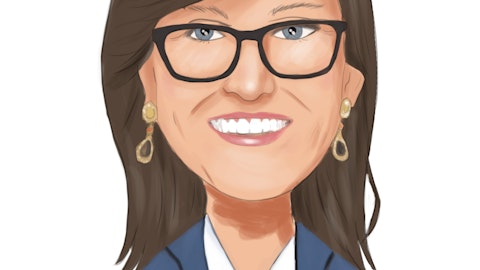DraftKings Inc. (NASDAQ:DKNG) Q3 2023 Earnings Call Transcript November 3, 2023
Operator: Good day, and thank you for standing by. Welcome to the DraftKings Q3 2023 Earnings Call. At this time, all participants are in a listen-only mode. After the speakers’ presentation, there will be a question-and-answer session. [Operator Instructions] Please be advised today’s conference is being recorded. I would now like to hand the conference over to your speaker today, Stanton Dodge, Chief Legal Officer. Please go ahead.
Stanton Dodge: Good morning, everyone, and thank you for joining us today. Certain statements we make during this call may constitute forward-looking statements that are subject to risks, uncertainties and other factors as discussed further in our SEC filings that could cause our actual results to differ materially from our historical results or from our forecast. We assume no responsibility to update forward-looking statements other than as required by law. During this call, management will also discuss certain non-GAAP financial measures that we believe may be useful in evaluating DraftKings’ operating performance. These measures should not be considered in isolation or as a substitute for DraftKings financial results prepared in accordance with GAAP.
Reconciliations of these non-GAAP measures to the most directly comparable GAAP measures are available in our earnings release and presentation, which can be found on our website and in our quarterly report on Form 10-Q filed with the SEC. Hosting the call today, we have Jason Robins, Co-Founder and Chief Executive Officer of DraftKings, who will share some opening remarks and an update on our business; and Jason Park, Chief Financial Officer of DraftKings, who will provide a review of our financials. We will then open the line to questions. I will now turn the call over to Jason Robins.
Jason Robins: Good morning, and thank you all for joining. The first three quarters of 2023 have been outstanding for DraftKings. We have made thoughtful investments in our product throughout the year and are winning with our customers, and our team executed tremendously around the start of NFL and college football season. Importantly, we remain focused on our core value drivers, acquiring customers efficiently, retaining and monetizing our existing customers, entering new jurisdictions and building an efficient and scaled organization. I’m pleased to share that this strong execution and focus resulted in another excellent quarter. Revenue and adjusted EBITDA exceeded our expectations and our momentum continued into the fourth quarter with the start of the basketball and hockey seasons.
We are raising our expectations for fiscal year 2023 and introducing initial guidance for fiscal year 2024. In 2024, we expect revenue of $4.5 billion to $4.8 billion and positive adjusted EBITDA of $350 million to $450 million. We also expect to generate meaningfully positive free cash flow in fiscal year 2024. As we look back on the third quarter in 2023, here are our key takeaways. First, we are winning. Our revenue in the quarter increased 57% year-over-year, and we achieved number one combined OSB and iGaming gross gaming revenue share in the U.S. We’ve efficiently added over 1,000 basis points of combined OSB and iGaming shares since the second quarter of 2022, which we are very proud of. Second, our investments in product and technology are paying off.
We have created what we believe is the strongest product in the industry and are seeing overall engagement on our app and structural hold percentage continue to increase. Importantly, we have a clear road map to extend our product advantage over the coming years. Third, our older states are generating significant contribution profit, and newer states are generating positive contribution profit faster than previous states. Fourth, we expect attractive adjusted EBITDA flow through percentage on incremental revenue as we believe our organization is largely at scale and therefore, has a long runway of margin improvement. Finally, the best is yet to come. We are excited for the future and look forward to presenting our latest views on the U.S. opportunity, sources of competitive differentiation, core business drivers, including additional details on unit economics and our multiyear financial outlook at our Investor Day on November 14.
With that, I will turn it over to Jason Park.

Jason Park: Thank you, Jason. I’ll hit the highlights, including our very strong third quarter performance, increased 2023 guidance and our initial expectations for 2024. Please note that all income statement measures discussed except for revenue, are on a non-GAAP adjusted EBITDA basis. As Jason mentioned, the organization is executing very well, and that is showing up in our results. We achieved $790 million of revenue in the quarter, which is 57% higher than our third quarter 2022 revenue, and our adjusted EBITDA of negative $153 million improved by $111 million on a year-over-year basis. Customer retention and engagement far exceeded our expectations as customers enjoyed our live same game parlay offering as well as our live and player prop markets.
MLB was a bright spot throughout the third quarter and we successfully transitioned many of those customers into the football season. Customer acquisition was also healthy and exceeded expectations. For example, we have already acquired more than 5% of the adult population in Kentucky following the launch of our Sportsbook product in that state on September 28. Structural hold was above 9.5% during the quarter and well ahead of expectations as we continue to improve our parlay mix and optimize our trading capabilities. Our actual Sportsbook hold percentage was approximately 9%, inclusive of customer-friendly sport outcomes, primarily in college football and the NFL. Promotional reinvestment as a percentage of GGR outperformed our expectations due to stronger than anticipated retention of existing customers, which resulted in a slightly higher mix of existing customers versus new customers.
Promotions as a percentage of GGR continue to improve on a year-over-year basis for our OSB and iGaming states. Our adjusted gross margin was in line with expectations and increased almost 300 basis points year-over-year. Strong handle growth combined with improving structural sportsbook hold rate and better promotional reinvestment for OSB & iGaming contributed to higher adjusted gross margin. External marketing and fixed expenses were consistent with our plans as we executed our football season kickoff and continue to exert discipline against our compensation expenses and vendor-related costs. We’re very pleased with our results in our more mature OSB and iGaming state. In the states that launched from 2018 through 2021, we continue to drive very strong handle and revenue growth year-over-year with a corresponding improvement in adjusted gross margin rate, while our external marketing costs decreased at a double-digit rate.
Our strong third quarter results and our visibility into continued improvement have enabled us to significantly raise our expectations for 2023 revenue and adjusted EBITDA. We are improving our full year 2023 revenue guidance range to $3.67 billion to $3.72 billion or by $195 million at the midpoint. We are also improving our full year 2023 adjusted EBITDA guidance range to negative $95 million to negative $115 million or by $100 million at the midpoint. The bridge from the 2023 revenue and adjusted EBITDA guidance that we shared in August to our 2023 guidance as of today include stronger customer retention, acquisition and engagement and structural sportsbook hold improvement, partially offset by customer-friendly sport outcomes in the third quarter and our expected launch in May.
You can see the details of the bridge in the earnings presentation we posted to our website. In terms of our full year, we are increasing our 2023 adjusted gross margin rate guidance to 43.5% to 45%. We now expect contribution profit, which we define as adjusted gross profit less external marketing to approach $800 million in fiscal year 2023. We continue to expect fixed cost to grow less than 10% and external marketing to be consistent with prior guidance even when including our investment in May. With regard to our balance sheet, we ended the second quarter with $1.1 billion of cash and now plan to end the year with more than $1.2 billion of cash. As a reminder, we expect approximately $120 million of capital expenditures and capitalized software development costs for fiscal year 2023, and changes in net working capital to be a modest source of cash.
We expect this level of CapEx to continue in 2024. Moving on to our full year 2024 guidance. We are poised for a rapid increase in adjusted EBITDA due to continued strong revenue growth, coupled with a scaled fixed cost structure. For 2024, we expect revenue in the range of $4.5 billion to $4.8 billion or nearly $1 billion of incremental revenue growth compared to the midpoint of our fiscal 2023 revenue guidance and more than double our revenue from 2022. Our guidance range for 2024 adjusted EBITDA is $350 million to $450 million, which equates to more than $500 million of year-over-year growth compared to the midpoint of our fiscal year 2023 adjusted EBITDA guidance and more than $1.1 billion of adjusted EBITDA improvement since 2022. Our guidance range for 2024 includes investments to launch approximately 5% of the adult population.
In addition, based on the midpoints of our fiscal year 2023 and 2024 guidance ranges, we expect year-over-year adjusted EBITDA flow-through percentage up 53%, which we look forward to delivery. In sum, we had an excellent third quarter and are very excited about the trajectory of our business. We look forward to sharing more details at our upcoming Investor Day. That concludes our remarks, and we will now open the line for questions.
See also 15 Vacations for Seniors on a Budget and 11 Undervalued Mid Cap Stocks To Buy According to Analysts.
Q&A Session
Follow Draftkings Holdings Inc. (NASDAQ:DKNG)
Follow Draftkings Holdings Inc. (NASDAQ:DKNG)
Operator: Thank you, ladies and gentlemen. [Operator Instructions] Our first question comes from Shaun Kelley with Bank of America. Your line is open.
Shaun Kelley: Hi. Good morning, everyone. Thanks you for taking my question. Just wanted to start with sales and marketing. I think one of the many things we learned this quarter was seeing your overall sales and marketing actually declined year-over-year, and I believe implying external marketing down even more during the quarter. As we look out to next year, I think that pattern actually continues. And I was just wondering if you could elaborate a little bit on what’s enabling you to do that and still make the investments that you hope to? And sort of just talk to us a little bit about both mix, meaning new customers acquired versus existing and also seasonality, if you could, just how should we think about external marketing across the year? Thank you.
Jason Robins: Thanks, Shaun. So you’re correct that we do expect to further decline in external marketing next year, and that is inclusive of potential launches in North Carolina as well as some other states. So all specifically the states that have legalized not any new states we’re predicting legalization. And I think the biggest reason why is that as our existing states mature, we see less and less external marketing spend there. We are still continuing to acquire customers even in our old estate vintages. So we do still have marketing spend allocated to those. But it’s certainly not nearly at the same level as in the first year, two, three of the state. So as states mature, that comes down. And so just generally, as the business is maturing, we’re seeing that happen, which is what we expected, of course, if we see some very significant new states come online next year, that could change.
But right now based on the kind of launch that we expect to launch, we’re forecasting an external marketing decline next year.
Operator: Thank you. One moment for our next question. Our next question comes from Jeff Greff with JPMorgan. Your line is open.
Joseph Greff: Good morning, guys.
Operator: Sorry, Joe, sorry about that.
Joseph Greff: When you look out to 2024 and you look at — when you roll up your guidance and your forecast. And when you look at OSB older states and newer states, is there a more meaningful contribution coming from the older states or how are you looking at between the different cohorts and vintages?
Jason Robins: Yeah. It’s a great question. We actually are going to dive into that very specific topic in much more granular detail at our Investor Day on the 14th. So I very much look forward to sharing detail there. And I think the way you could think about it is, if you look at sort of the relative population sizes of the different vintages and then think about the maturity curve, obviously, the older states are still growing. So on a per capita basis, they will be larger. And then if you kind of think about how big each vintage is based on the percentage of population, and then also think about the mix of whether it’s just OSB or OSB and iGaming, that will give you a picture of how much. But we actually are going to go into a much more specific detail on this on the 14th.
And I was very certainly warm by my IR team not to run the front run in the Investor Day. So it won’t – but it’s a great question and look forward to sharing more with you in a couple of weeks.
Joseph Greff: Great. Thanks, guys.
Operator: One moment for our next question. Our next question comes from Stephen Grambling with Morgan Stanley. Your line is open.
Stephen Grambling: Hey, thanks. Clearly, there’s been a lot of concerns or questions about the competitive environment, whether new entrants or existing folks who perhaps need to protect share. How are you planning for promotions into 2024 versus ’23 in the guidance that you provided and could there be a reallocation from marketing savings that you’re discussing?
Jason Robins: We continue — excuse me, it’s a great question. We continue to expect to see a decline in promotions. I know that there are a couple of states that report them that different data can be extrapolated, but it’s always tricky to kind of look at a couple of seats. We actually saw a decline year-over-year in promotion rate for our overall OSB and iGaming business in Q3. Obviously, as you know, we saw a gross margin increase of about 300 bps year-over-year. Next year, we forecasted a 200 bps to 300 bps gross margin increase, and that’s mostly from promotional decline. There’s a little bit of hold rate increase in there too. But definitely, we’ll stay disciplined. We’ve seen multiple waves of competition. Last time we saw a huge wave of competition.
We stayed disciplined. We didn’t increase our promotion rate and I don’t think we expect to do that this time. So we certainly contemplated a variety of different scenarios in our guidance. And at this point, I think we have a decent amount of experience and historical data on different types of competition that might emerge. But I think the important thing for us is just to continue what we’ve done all along, which is to stay disciplined to focus on bringing down promotion rate through optimization. And then just naturally, I think continuing to see the user base matures and so much of that promotion goes to new customers. And I think if we continue to do that and execute well, the trends that we’ve been seeing for the last seven, eight quarters will continue.
Stephen Grambling: Sounds good. Thank you.
Operator: One moment for our next question. Our next question comes from Carlo Santarelli with Deutsche Bank. Your line is open.
Carlo Santarelli: Hey, guys. Thank you. Jason, when you guys think about your guidance for ’24 within the context of the share gains that you guys have shown consistently but really stepped up in the 3Q. How are you thinking about — I think relative to the 33% is what you guys had in the release that’s blended across both channels. How do you guys think about that share within the context of next year’s net revenue and EBITDA guidance? Is it flattish, moving up, et cetera?
Jason Robins: Yeah. It’s a great question. I mean what we’ve always sort of typically guided the same way, which is we look at historical cohorts and data, project forward based on that. So implicitly, that generally implies a flat share. And I think a lot of why we outperformed this year by such a significant margin was just our share increase. So certainly not banking on that for next year. We’re confident that we have some opportunity there, and we believe that we can. But as far as what’s embedded in the guidance, our methodology hasn’t changed. We look at historical cohorts, which kind of implicitly implies flat share and any projection going forward.
Carlo Santarelli: Great. Thank you. And then obviously, based on your scale at this point and the flow-through that you guys expect to receive or generate going forward. I guess the next question kind of becomes — looking back to your March Analyst Day when I think you guys laid out gross margins of like 56% at a steady state and some of the buckets, platform processing, et cetera, that would kind of contribute to that. How do you think about like kind of the evolution of maybe whittling down some of those costs, whether it be within processing or revenue share? And how far are we from having that as kind of a talking point around improving that gross margin?





